Unit 7 Food festival Topic 2 I’m not sure whether I can cook it well. Section D 课件(23张PPT,内嵌音频)
文档属性
| 名称 | Unit 7 Food festival Topic 2 I’m not sure whether I can cook it well. Section D 课件(23张PPT,内嵌音频) | 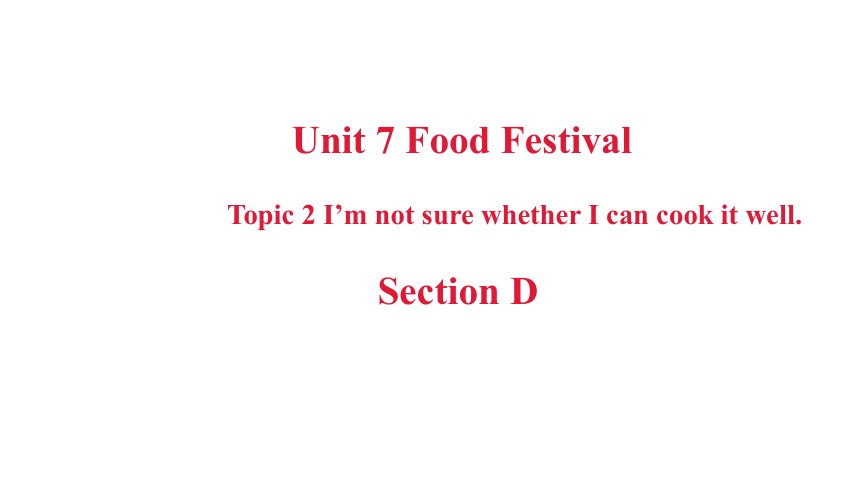 | |
| 格式 | pptx | ||
| 文件大小 | 3.5MB | ||
| 资源类型 | 教案 | ||
| 版本资源 | 仁爱科普版 | ||
| 科目 | 英语 | ||
| 更新时间 | 2021-05-11 14:41:49 | ||
图片预览




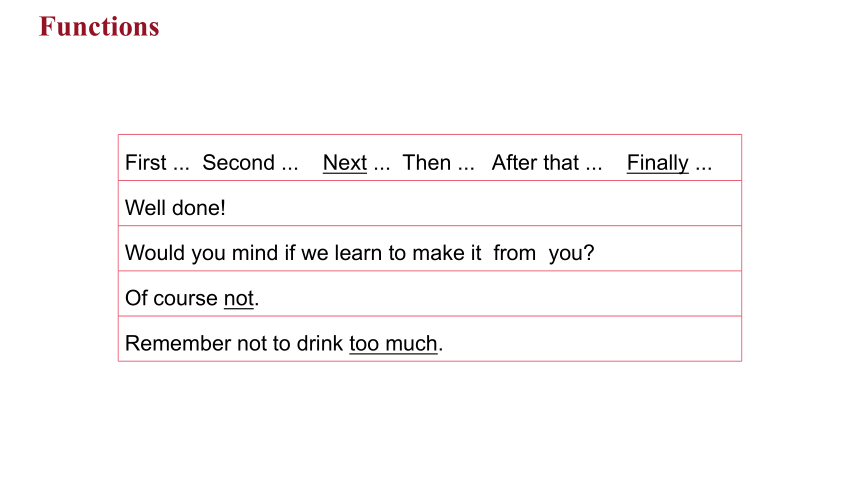

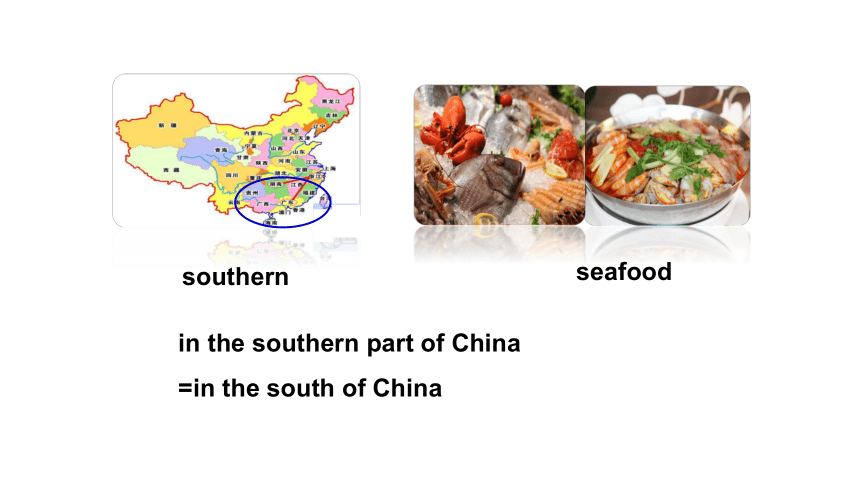
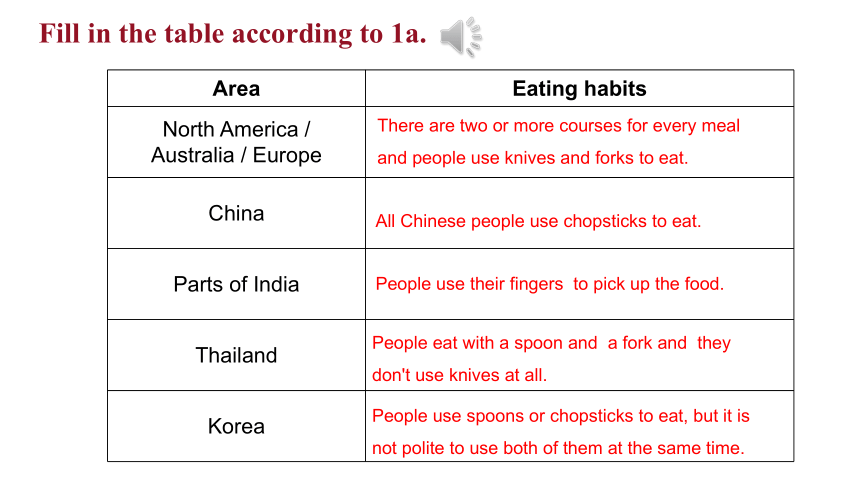
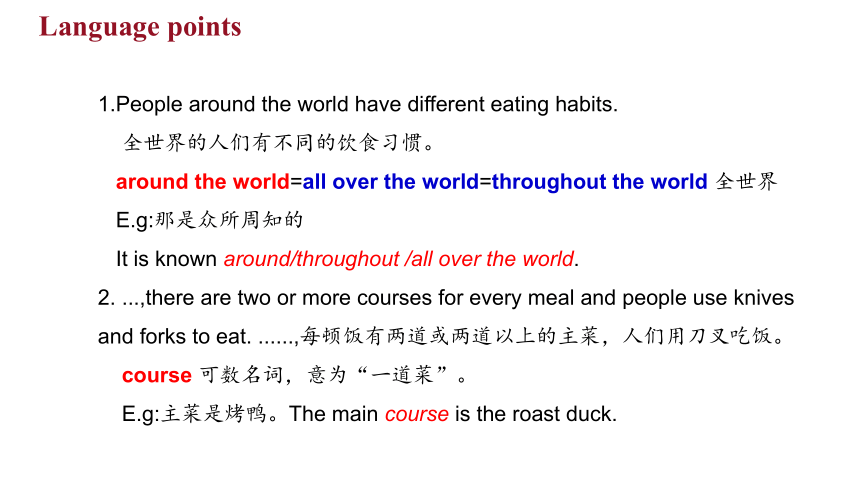
文档简介
Unit 7 Food Festival
Topic 2 I’m not sure whether I can cook it well.
Section D
New words:
自主学习
v.进餐,用饭
n.肘,肘部
n.匙,调羹
n.筷子
n.手指
adj.南方的;南部的
n.海鲜,海味
v.采,摘;拾起,采集;挑选
捡起;获得;收拾
n.香肠
dine
elbow
spoon
chopstick
finger
southern
seafood
pick
pick up
sausage
Sentences:
自主学习
1.I want to know whether/if it is polite to point with chopsticks at people in China.
2.Do you know whether or not it’s impolite to smoke during a meal in France?
3.Is it polite to point at people with chopsticks in China?
=> I want to know whether/if it is polite to point at people with chopsticks in China.
=>I don’t think that it is polite to point at people with chopsticks in China.
{E8B1032C-EA38-4F05-BA0D-38AFFFC7BED3}Object Clauses(Ⅱ)
But I'm not sure whether/if I can cook it well.
Can you tell me if/whether it's polite to eat with your arms or elbows on the table in America?
Do you know whether or not it's impolite to smoke during a meal in France?
{E8B1032C-EA38-4F05-BA0D-38AFFFC7BED3}Comparative and Superlative Degrees of Adverbs(Ⅰ)
Jane arrives early. Michael arrives earlier.
Kangkang arrives earliest.
Grammar
{E8B1032C-EA38-4F05-BA0D-38AFFFC7BED3}First ... Second ... Next ... Then ... After that ... Finally ...
Well done!
Would you mind if we learn to make it from you?
Of course not.
Remember not to drink too much.
Functions
Would you please tell me something about
a formal western dinner ?
seafood
southern
in the southern part of China
=in the south of China
Area
Eating habits
North America /
Australia / Europe
China
Parts of India
Thailand
Korea
There are two or more courses for every meal and people use knives and forks to eat.
All Chinese people use chopsticks to eat.
People use their fingers to pick up the food.
People use spoons or chopsticks to eat, but it is not polite to use both of them at the same time.
People eat with a spoon and a fork and they don't use knives at all.
Fill in the table according to 1a.
1.People around the world have different eating habits.
全世界的人们有不同的饮食习惯。
around the world=all over the world=throughout the world 全世界
E.g:那是众所周知的
It is known around/throughout /all over the world.
2. ...,there are two or more courses for every meal and people use knives and forks to eat. ......,每顿饭有两道或两道以上的主菜,人们用刀叉吃饭。
course 可数名词,意为“一道菜”。
E.g:主菜是烤鸭。The main course is the roast duck.
Language points
3.In parts of India, people use their fingers to pick up the food.
在印度有些地方,人们用手指头拿食物吃。
pick up 拿起,捡起;接某人;取某物;搭便车。
E.g:电话铃响了,我拿起了话筒。
The phone rang and I picked it up.
我的哥哥会开车来接你的。
My brother will pick you up in the car.
Language points
Eating Habits
People around the world have different eating habits.
In North America, Australia and Europe, there are two or more courses for every meal and people use knives and forks to eat.
In the southern part of China, people eat rice a lot, while in the north people often eat noodles. In the central and western parts, people are far away from the sea, so they don’t eat much seafood. But all Chinese people use chopsticks to eat.
In parts of India, people use their fingers to pick up the food.
In Thailand,people eat with a spoon and a fork and they don't use knives at all.
In Korea, people use spoons or chopsticks to eat, but it is not polite to use both of them at the same time.
Listen and follow
different eating habits
North America, Australia, Europe, courses , knives, forks.
southern part of China, rice, north, noodles, central, western, don’t, seafood, chopsticks.
parts of India, fingers, pick up.
Thailand, spoon,fork, don't use knives.
Korea, spoons, chopsticks, not polite, both.
Retell the passage with the help of key words.
Talk about eating habits in different parts of the world according to 1.
Example:
A: Can you tell me if there are two or more courses for every meal in North America, Australia and Europe?
B: Yes, I think so.
A: Do you know if people in the south of China often eat noodles?
B: No, I don’t think so. But sometimes they do.
2 Suppose you are Beth.Report the following interview notes to your partner.
{E8B1032C-EA38-4F05-BA0D-38AFFFC7BED3}Beth
Tom
Is the most popular food in your restaurant hot dogs?
Yes,it is.
Are the sausages in your hot dogs different from those in others?
Yes,they are.
Are dumplings your favorite Chinese food?
No,they aren't.
Do you like Chinese food?
No,not at all.
Example:
I ask Tom if/whether the most popular food in his restaurant is hot dogs.And he says it is.
3 Look at the pictures and write a passage about how to cook chicken soup.
cut up
wash
put...into
boil
add salt,
green onions
ready,
enjoy
Example:
Chicken soup is very delicious, and it’s good for our health. Would you like to eat some chicken soup? Well, let’s cook it together.
First, cut up chicken. Next, wash the chicken and put it into a deep pot 70% -80% full of water. Then, boil the chicken for about 2 hours. Finally, add some salt, green onions and so on. Now the chicken soup is ready and you can enjoy it.
Table Manners in Different Countries
Prepare some hats with country names, such as Japan and
Cuba on them.
The students wearing the hats will do some eating actions.The other students guess and discuss.
What’s he / she doing?
Is it polite to do this during dinner in Japan / Cuba ...?
Is it polite to put arms or elbows on the table in Japan / Cuba ...?
3. Write a passage about table manners in different countries.
Project
1. Some new words:
southern,seafood,pick
2.Some phrases:
eating habits, in the southern part of, pick up, at the same time
3.To review object clauses:
But I'm not sure whether/if I can cook it well.
I ask Tom if/whether the most popular food in his restaurant is hot dogs.
Do you know whether or not it's impolite to smoke during a meal in France?
Summary
1.Talk about different eating habits around the world:
In North America, Australia and Europe, there are two or more courses for every meal and people use knives and forks to eat.
In Korea, people use spoons or chopsticks to eat, but it is not polite to use both of them at the same time.
2.Talk about how to cook chicken soup.
Summary
( ) 1. Don’t worry. My father will ____ us up in the car if it rains tomorrow.
A. bring B. take C. pick
( ) 2. I don’t know ____ it’s polite or not to eat with our arms or elbows
on the table in America.
A. if B. whether C. that
( ) 3. ---Would you mind if I learn English from you?
---__________. I am very glad to teach you.
A. Of course not. B. You’d better not. C. Sounds great.
( ) 4. All Chinese use chopsticks________.
A. eat B. to eat C. eating
( ) 5.In the _______ part of China,people eat rice and fish a lot.
A. south B. southes C. southern
C
B
A
B
C
Exercises
综合短文填空。
When you go to a dinner party in the U.S.A, you’d better bring a small present. It’s nice to bring some d______, such as juice, beer or something like that. You should a_____ on time or no more than five minutes late. Don’t get there e_____. If you are going to be more than fifteen m______ late, you should call them or let them know. Try to be relaxed and p_____. If you don’t know h____ to use the knife and fork, don’t be nervous. You can watch other people and f_____them. If you still have no idea, ask the person n____to you. If you like the food, you should say what you t____ of it. Of course, you should thank the host a_____the meal. Usually a thank-you card is sent after the party.
rinks
rrive
arly
inutes
olite
ow
ollow
ext
hink
fter
Exercises
1.Write a passage about table manners in different countries.
2.Finish exercises of Unit 7 Topic 2 Section D.
3.Review Topic 2 and preview Section A of Unit 7 Topic 3.
Homework
Bye-bye!
Topic 2 I’m not sure whether I can cook it well.
Section D
New words:
自主学习
v.进餐,用饭
n.肘,肘部
n.匙,调羹
n.筷子
n.手指
adj.南方的;南部的
n.海鲜,海味
v.采,摘;拾起,采集;挑选
捡起;获得;收拾
n.香肠
dine
elbow
spoon
chopstick
finger
southern
seafood
pick
pick up
sausage
Sentences:
自主学习
1.I want to know whether/if it is polite to point with chopsticks at people in China.
2.Do you know whether or not it’s impolite to smoke during a meal in France?
3.Is it polite to point at people with chopsticks in China?
=> I want to know whether/if it is polite to point at people with chopsticks in China.
=>I don’t think that it is polite to point at people with chopsticks in China.
{E8B1032C-EA38-4F05-BA0D-38AFFFC7BED3}Object Clauses(Ⅱ)
But I'm not sure whether/if I can cook it well.
Can you tell me if/whether it's polite to eat with your arms or elbows on the table in America?
Do you know whether or not it's impolite to smoke during a meal in France?
{E8B1032C-EA38-4F05-BA0D-38AFFFC7BED3}Comparative and Superlative Degrees of Adverbs(Ⅰ)
Jane arrives early. Michael arrives earlier.
Kangkang arrives earliest.
Grammar
{E8B1032C-EA38-4F05-BA0D-38AFFFC7BED3}First ... Second ... Next ... Then ... After that ... Finally ...
Well done!
Would you mind if we learn to make it from you?
Of course not.
Remember not to drink too much.
Functions
Would you please tell me something about
a formal western dinner ?
seafood
southern
in the southern part of China
=in the south of China
Area
Eating habits
North America /
Australia / Europe
China
Parts of India
Thailand
Korea
There are two or more courses for every meal and people use knives and forks to eat.
All Chinese people use chopsticks to eat.
People use their fingers to pick up the food.
People use spoons or chopsticks to eat, but it is not polite to use both of them at the same time.
People eat with a spoon and a fork and they don't use knives at all.
Fill in the table according to 1a.
1.People around the world have different eating habits.
全世界的人们有不同的饮食习惯。
around the world=all over the world=throughout the world 全世界
E.g:那是众所周知的
It is known around/throughout /all over the world.
2. ...,there are two or more courses for every meal and people use knives and forks to eat. ......,每顿饭有两道或两道以上的主菜,人们用刀叉吃饭。
course 可数名词,意为“一道菜”。
E.g:主菜是烤鸭。The main course is the roast duck.
Language points
3.In parts of India, people use their fingers to pick up the food.
在印度有些地方,人们用手指头拿食物吃。
pick up 拿起,捡起;接某人;取某物;搭便车。
E.g:电话铃响了,我拿起了话筒。
The phone rang and I picked it up.
我的哥哥会开车来接你的。
My brother will pick you up in the car.
Language points
Eating Habits
People around the world have different eating habits.
In North America, Australia and Europe, there are two or more courses for every meal and people use knives and forks to eat.
In the southern part of China, people eat rice a lot, while in the north people often eat noodles. In the central and western parts, people are far away from the sea, so they don’t eat much seafood. But all Chinese people use chopsticks to eat.
In parts of India, people use their fingers to pick up the food.
In Thailand,people eat with a spoon and a fork and they don't use knives at all.
In Korea, people use spoons or chopsticks to eat, but it is not polite to use both of them at the same time.
Listen and follow
different eating habits
North America, Australia, Europe, courses , knives, forks.
southern part of China, rice, north, noodles, central, western, don’t, seafood, chopsticks.
parts of India, fingers, pick up.
Thailand, spoon,fork, don't use knives.
Korea, spoons, chopsticks, not polite, both.
Retell the passage with the help of key words.
Talk about eating habits in different parts of the world according to 1.
Example:
A: Can you tell me if there are two or more courses for every meal in North America, Australia and Europe?
B: Yes, I think so.
A: Do you know if people in the south of China often eat noodles?
B: No, I don’t think so. But sometimes they do.
2 Suppose you are Beth.Report the following interview notes to your partner.
{E8B1032C-EA38-4F05-BA0D-38AFFFC7BED3}Beth
Tom
Is the most popular food in your restaurant hot dogs?
Yes,it is.
Are the sausages in your hot dogs different from those in others?
Yes,they are.
Are dumplings your favorite Chinese food?
No,they aren't.
Do you like Chinese food?
No,not at all.
Example:
I ask Tom if/whether the most popular food in his restaurant is hot dogs.And he says it is.
3 Look at the pictures and write a passage about how to cook chicken soup.
cut up
wash
put...into
boil
add salt,
green onions
ready,
enjoy
Example:
Chicken soup is very delicious, and it’s good for our health. Would you like to eat some chicken soup? Well, let’s cook it together.
First, cut up chicken. Next, wash the chicken and put it into a deep pot 70% -80% full of water. Then, boil the chicken for about 2 hours. Finally, add some salt, green onions and so on. Now the chicken soup is ready and you can enjoy it.
Table Manners in Different Countries
Prepare some hats with country names, such as Japan and
Cuba on them.
The students wearing the hats will do some eating actions.The other students guess and discuss.
What’s he / she doing?
Is it polite to do this during dinner in Japan / Cuba ...?
Is it polite to put arms or elbows on the table in Japan / Cuba ...?
3. Write a passage about table manners in different countries.
Project
1. Some new words:
southern,seafood,pick
2.Some phrases:
eating habits, in the southern part of, pick up, at the same time
3.To review object clauses:
But I'm not sure whether/if I can cook it well.
I ask Tom if/whether the most popular food in his restaurant is hot dogs.
Do you know whether or not it's impolite to smoke during a meal in France?
Summary
1.Talk about different eating habits around the world:
In North America, Australia and Europe, there are two or more courses for every meal and people use knives and forks to eat.
In Korea, people use spoons or chopsticks to eat, but it is not polite to use both of them at the same time.
2.Talk about how to cook chicken soup.
Summary
( ) 1. Don’t worry. My father will ____ us up in the car if it rains tomorrow.
A. bring B. take C. pick
( ) 2. I don’t know ____ it’s polite or not to eat with our arms or elbows
on the table in America.
A. if B. whether C. that
( ) 3. ---Would you mind if I learn English from you?
---__________. I am very glad to teach you.
A. Of course not. B. You’d better not. C. Sounds great.
( ) 4. All Chinese use chopsticks________.
A. eat B. to eat C. eating
( ) 5.In the _______ part of China,people eat rice and fish a lot.
A. south B. southes C. southern
C
B
A
B
C
Exercises
综合短文填空。
When you go to a dinner party in the U.S.A, you’d better bring a small present. It’s nice to bring some d______, such as juice, beer or something like that. You should a_____ on time or no more than five minutes late. Don’t get there e_____. If you are going to be more than fifteen m______ late, you should call them or let them know. Try to be relaxed and p_____. If you don’t know h____ to use the knife and fork, don’t be nervous. You can watch other people and f_____them. If you still have no idea, ask the person n____to you. If you like the food, you should say what you t____ of it. Of course, you should thank the host a_____the meal. Usually a thank-you card is sent after the party.
rinks
rrive
arly
inutes
olite
ow
ollow
ext
hink
fter
Exercises
1.Write a passage about table manners in different countries.
2.Finish exercises of Unit 7 Topic 2 Section D.
3.Review Topic 2 and preview Section A of Unit 7 Topic 3.
Homework
Bye-bye!
同课章节目录
- Unit 5 Feeling excited
- Topic 1 You look excited
- Topic 2 I’m feeling better now.
- Topic 3 Many things can affect our feelings.
- Unit 6 Enjoying Cycling
- Topic 1 We're going on a three-day visit to Mount
- Topic 2 How about exploring Tian’anmen Square?
- Topic 3 Bicycle riding is good exercise.
- Unit 7 Food festival
- Topic 1 We’re preparing for a food festival.
- Topic 2 I’m not sure whether I can cook it well.
- Topic 3 I Cooked the Most Successfully
- Unit 8 Our Clothes
- Topic 1 We will have a class fashion show.
- Topic 2 We can design our own uniforms.
- Topic 3 He said the fashion show was wonderful.
